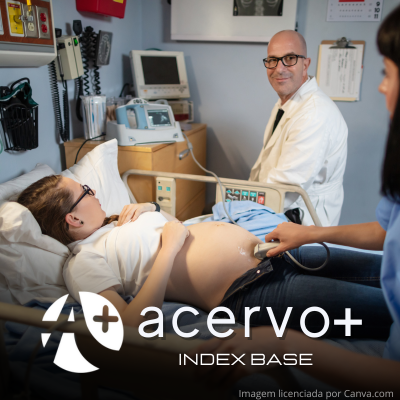Síndrome de DiGeorge e suas manifestações ultrassonográficas pré-natais
##plugins.themes.bootstrap3.article.main##
Resumo
Objetivo: Analisar a Síndrome de DiGeorge e suas manifestações ultrassonográficas pré-natais. Revisão bibliográfica: A Síndrome de DiGeorge é uma condição genética autossômica dominante decorrente da depleção do braço longo do cromossomo 22 (22q11.2). Essa síndrome afeta cerca de 1 a cada 3 mil nascidos vivos e apresenta distintos sinais e sintomas. As manifestações mais frequentes incluem malformações cardíacas, imunodeficiência decorrente de malformações tímicas, alterações craniofaciais, agenesia das paratireoides e anormalidades laringotraqueais. A ultrassonografia obstétrica é um método de baixo custo e já incluso na rotina pré-natal que pode ser útil no auxílio diagnóstico mais precoce. Suspeita-se da síndrome principalmente ao deparar-se com malformações cardíacas no segundo trimestre, sendo indicado investigação genética com o teste de análise de fluorescência in situ (FISH) para detecção da microdeleção do cromossomo 22. O tratamento baseia-se em suporte multiprofissional de forma individual aos fenótipos apresentados em cada indivíduo. Considerações finais: A Síndrome de DiGeorge possui múltiplos fenótipos e dessa forma o uso de tecnologias como a ultrassonografia pré-natal é viável como rastreio inicial para testes mais específicos como o FISH, buscando melhorar o desfecho obstétrico e fetal. Mais estudos para padronização dos achados da síndrome podem se tornar úteis para facilitar o rastreio.
##plugins.themes.bootstrap3.article.details##
Copyright © | Todos os direitos reservados.
A revista detém os direitos autorais exclusivos de publicação deste artigo nos termos da lei 9610/98.
Reprodução parcial
É livre o uso de partes do texto, figuras e questionário do artigo, sendo obrigatória a citação dos autores e revista.
Reprodução total
É expressamente proibida, devendo ser autorizada pela revista.
Referências
2. BUTENSKY A, et al. Cardiac Evaluation of Patients with 22q11.2 Duplication Syndrome. American Journal of Medical Genetics Part A, 2021; 185(3); 753-58.
3. CHEON EJ, et al. Cross disorder comparisons of brain structure in schizophrenia, bipolar disorder, major depressive disorder, and 22q11.2 deletion syndrome: A review of ENIGMA findings. Psychiatry and Clinical Neurosciences, 2022; 76(5): 140-161.
4. CHING CR, et al. Mapping Subcortical Brain Alterations in 22q11.2 Deletion Syndrome: Effects of Deletion Size and Convergence with Idiopathic Neuropsychiatric Illness. American Journal of Pshychiatry, 2020; 177(7): 589-600.
5. CORTÉS-MARTÍN J, et al. Deletion Syndrome 22q11.2: A Systematic Review. Children, 2022; 9(1168): 1-13.
6. DANTAS ATA, et al. DiGeorge Syndrome (Chromosome 22q11.2 Deletion): Therapeutics and Prognosis. Brazilian Journal of Development, 2023; 9(1): 3995-4012.
7. FREUD LR, et al. Prenatal vs Postnatal Diagnosis of 22q11.2 Deletion Syndrome: Cardiac and Noncardiac Outcomes Through 1 Year of Age. American Journal of Obstetrics and Gynecology, 2024; 230(368): 12.
8. GADSBØLL K, et al. Decoding 22q11.2: Prenatal Profiling and First- Trimester Risk Assessment in Danish Nationwide Cohort. Ultrasound in Obstetrics and Gynecology, 2024; 63(1): 34-43.
9. GÖKTOLGA Ü, et al. Prenatal Diagnosis of Digeorge Syndrome. Taiwanese Journal of Obstetrics and Gynecology, 2008; 47(4): 441-442.
10. ISGANDAROVA K, et al. Late Diagnosed DiGeorge Syndrome in a 44-year-old Female: a Rare Cause for Recurrent Syncopes in Adulthood – A Case Report. European Heart Journal Case Reports, 2021; 5(5): 166.
11. JIANG X, et al. Prenatal Diagnosis and Genetic Study of 22q11.2 Microduplication in Chinese Fetuses: A Series of 31 Cases and Literature Review. Molecular Genetix and Genomic Medicine, 2024; 12(7): 2498.
12. JING XY, LI DZ. Improved Outcomes in Patients with Prenatally Detected 22q11.2 Deletion Syndrome. American Journal of Obstetrics and Gynecology, 2024; 230(4): 49.
13. JONAS RK, et al. The 22q11.2 Deletion Syndrome as a Window Into Complex Neuropsychiatric Disorders Over the Lifespan. Biological Psychiatry, 2014; 75(5): 351–360.
14. KARIM JN, et al. First-trimester Ultrasound Detection of Fetal Heart Anomalies: Systematic Review and Meta-Analysis. Ultrasound in Obstetrics and Gynecology, 2022; 59(1): 11-25.
15. KUENSTNER W, et al. DiGeorge Syndrome Diagnosed at Age 38: Challenges in Low-resource Settings and Implications of a Missed Diagnosis. JCEM Case Reports, 2024; 2(7): 136.
16. MAEDER J, et al. Long-term verbal memory deficit and associated hippocampal alterations in 22q11.2 deletion syndrome. Child Neuropsychology, 2020; 26(3): 289-311.
17. MCDONALD-MCGINN DM, et al. 22q11.2 deletion syndrome. Nature Reviews Disease Primers, 2015; 1: 15071.
18. MELO KM, CARVALHO BTC. Síndrome de DiGeorge: Aspectos clínico-imunológicos e manejo. Revista Brasileira de Alergia e Imunopatologia, 2007; 30(2): 47-50.
19. NOËL AC, et al. Fetal Phenotype Associated With the 22q11 Deletion. American Journal of Medical Genetics Part A, 2014; 164(11): 2724-2731.
20. ÓSKARSDÓTTIR, S, et al. Updated clinical practice recommendations for managing children with 22q11.2 deletion syndrome. Genetics in Medicine, 2023; 25(3): 100338.
21. PEYROUX E, et al. Subthreshold social cognitive deficits may be a key to distinguish 22q11.2DS from schizophrenia. Early Intervention in Psychiatry, 2019; 13(2): 304-307.
22. PROJETO CRÂNIO-FACE BRASIL – BRASIL. Guia de Manejo Clínico para Pacientes com Síndrome de Deleção 22q11.2. CNPq. 2014. Disponível em: https ://www.fcm.unicamp.br/fcm/cranio-face-brasil/profissionais-da-saude/publicacoes-de-interesse. Acessado em: 12 de junho de 2024.
23. REIS IFV, et al. DiGeorge’s Syndrome: a case report. Brazilian Journal of Development, 2022; 8(8): 60150-60161.
24. SANTAMBROGIO J, et al. Percorso psichiatrico e psicologico per una giovane donna con sindrome da delezione del cromosoma 22 e disabilità intellettiva: Un buon outcome. Rivista di Psichiatria, 2020; 55(2): 106-111.
25. SCHINDEWOLF E, et al. Expanding the Fetal Phenotype: Prenatal Sonographic Findings and Perinatal Outcomes in a Cohort of Patients with a Confirmed 22q11.2 Deletion Syndrome. American Journal of Medical Genetics Part A, 2018; 176(8): 1735-1741.
26. SILVA CB e BRUSTOLONI YM. A difícil tarefa de diagnosticar precocemente a Síndrome de DiGeorge na população pediátrica: um relato de caso. Perspectivas Experimentais e Clínicas, Inovações Biomédicas e Educação em Saúde, 2019; 5(1): 18-22.
27. TRAISRISILP K, et al. Prenatal Screening of DiGeorge (22q11.2 Deletion) Syndrome by Abnormalities of the Great Arteries Among Thai Pregnant Women. Obstetrics and Gynecology Science, 2020; 63(3): 330-336.
28. XUE J, et al. 22q11.2 Recurrent Copy Number Variation-Related Syndrome: A Retrospective Analysis of our own Microarray Cohort and a Systematic Clinical Overview of ClinGen Curation. Translational Pediatrics, 2021; 10(12): 3273–3281.
29. ZHANG Z, et al. Chomatin Modifications in 22q11.2 Deletion Syndrome. Journal of Clinical Immunology, 2021; 41(8): 1853-1864.

